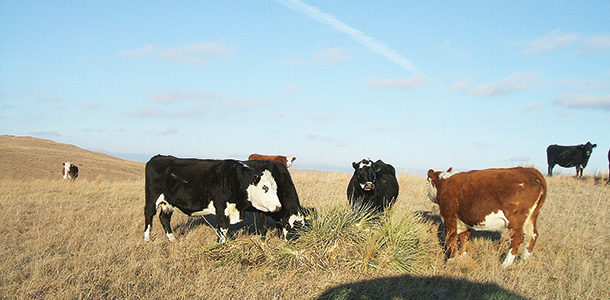Lynn Myers, of the family-owned Tippetts Ranch near Lewellen, Nebraska, is able to maximize his winter grazing system to the point that his Hereford and Hereford-Angus cross cattle graze for more than 10 months out of the year.
“We expect cows to go out and make a living on stockpiled grass, and they’ve done very well. But the cows are bred to do that. They know that they have to because we don’t nursemaid cows.”
Myers’ management style focuses on land conservation because he believes it is the most valuable resource he has.
Tippetts Ranch has used a three-year deferred rotational grazing system since 1985 to allow stockpiling grasses for late fall and winter grazing.
Myers refers to this system as “idiot-proof,” saying that it is simple enough to help make up for the mistakes he has made over the years.
The system is set up so that each pasture is completely rested every three years during the growing season to allow winter stockpiling.
A pasture will be used during cool-season grazing one year. It will be used for warm-season grazing the next year and rested during the growing season the third year.

Each pasture will host Myers’ 250 to 300 head of cattle for about a month at about .65 animal units (AU).
The deferred pastures are left standing, allowing the cows to graze by digging for the roughage under the snow. Additional nutrition is provided through a cake protein supplement.
Myers says, “As long as you supplement them with a protein and the snow doesn’t get really deep, the cows are very capable of going out and making a living on their own. I want them to work for me. I don’t want to work for a cow.”
These cows have been bred specifically to be able to not only survive but flourish in these conditions. Tippetts Ranch very rarely brings in outside cattle other than bulls.
The operation is based on a combination of Hereford and Hereford-Angus cross cattle. Myers says he uses this breed because he finds they are more willing to go out and forage when other cattle will not, even during bad weather.
Size is also an issue. He says that a 1,600-pound cow won’t fare very well in his system because of increased nutritional needs. Myers uses moderately framed cattle between 1,050 and 1,200 pounds.
“Some people say we are nuts because we’re still Hereford-based, but that’s all right. Our cows sell very well. We’ve got people who come back year after year after them,” says Myers.
By allowing the cattle to harvest the feed themselves, production costs are cut dramatically not only in terms of man-hours but in feed cost as well.
Myers points out that the cheapest way to feed cattle is to use what is already available on the ranch. Any time outside resources are needed, costs go up.
Because Myers is able to graze his cattle so successfully, he has been asked to teach his low-cost techniques to others through mentoring and speaking assignments.
“I guess our philosophy is pretty simple. Let the cow do as much as possible. Take care of her, but the best way to take care of her is to take care of the land, and she’ll take care of feeding herself if she’s the right kind of cow.” FG
PHOTOS
Using stockpiled grasses, Lynn Myers of Lewellen, Nebraska will graze his cattle more than 10 months a year. Photo courtesy of Lynn Myers.








